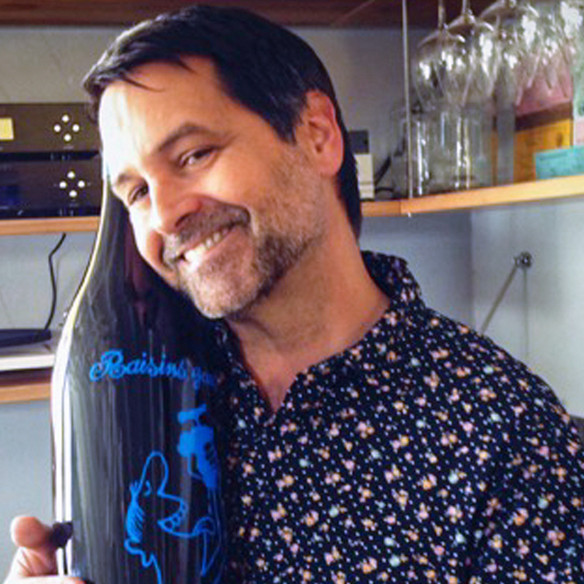Square seller DIG Wines, located in San Francisco’s up-and-coming Dogpatch neighborhood, is an intimate wine shop, focusing on French and Italian bottles. Since it opened four years ago, it’s quickly become a beloved neighborhood gathering spot. We caught up with owner Wayne Garcia to learn how he’s cultivated such a community.
Square: How did DIG Wines start out?
Garcia: I’ve been interested in wine basically since I was of legal drinking age. About 10 years ago I almost opened a wine shop, but it was the classic “wrong time/wrong place” scenario. To make a long story short, my wife opened a restaurant called Piccino in Dogpatch nine years ago I oversaw the wine program. When this building became available, we decided it was a good time to expand Piccino and also revisit that dream.
And you’re in a really old, historic building?
Yes, it was built in 1860, and the whole thing had to be retrofitted. The original foundation was held together by what seemed like bricks and beer bottles. And it’s really small space—only 300 square feet. I really like that, though. Unlike most wine shops, which have something from all over the world, the small space allows me to be super focused on what I want to do.
You focus on wines from Italy and France?
Yes, my passions lie there. I only carry 200 bottles in my store at a time, and each one has to earn a space in my shop, whether it costs $18 or a few hundred bucks. They all have a reason for being here. I don’t just carry things because they’re popular. Most of my wines are from very small producers—one of them makes only 800 cases a year.
How do you find wines?
I work very closely with importers to get stuff that you won’t find in many places. I also want my wines to be harmonious with food, which means I don’t choose things that are very high in alcohol or overtly fruity. Most of the wines I carry are 13.75% alcohol or below. I like wines that go well with food, and that have the right balance of fruit, acidity, and minerality. That harmony make wine interesting to me.
What’s your process for deciding what you want to carry?
Owning a wine shop is not as glamorous as it sounds–but no job is, really. It means that you have to taste through a lot of bottles, and a lot of mediocre wine. But you never know when you’re going to come across a little-known gem. The biggest challenge is remaining open-minded while also being super selective. I choose the importers I work with very carefully.
It sounds like you choose everything very carefully.
I made a decision pretty early on to trust my instincts. I want to present everything I do here with an old-fashioned brick and mortar integrity. That means that if people ask for something I don’t carry—I’ll tell them why and then steer them to something else they might like. If you like what’s happening at DIG I take credit for that. if you don’t like what’s happening here, I take the blame. Everything I do here is very personalized.
And you have great relationships with your customers because of that.
I often compare wine with human relationships. The best wines have something to say. They’re complex, and they’re not going to show you everything right off-the-bat. They make you get to know them. As with people, you sit down and have dinner together, and over the course of the evening you learn what makes them special.
How do you compare that to your relationship with your customers?
Customer relationships are a very similar thing to wine. Sometimes it takes a few visits before you really get to know someone. You have to really get to know them and what they like, and establish a deeper relationship. And soon you see the same people show up regularly every weekend for tastings. I now have half a dozen super-close friends that I met at the shop.
How do you work that ethos into the design of the shop?
A lot of wine shops are really stuffy. I designed the space to be very warm and inviting, with whimsical touches. It’s turned into wonderful little community gathering spot. The store is very intimate so I have a chance to really connect with people one on one.
Wine can be intimidating for some people. How do you make them feel comfortable about asking questions?
The first thing I tell people is that it’s okay not to know. One of the things I love about wine is that I’ll never learn it all. Just when you think you have it all figured out, you’re surprised by something. Burgundy alone is a life-long study. I also tell people to always trust their palates because they evolve. You might like something at a certain time in your life, but as you get more experienced, your palette can change. Always pay attention to what you like, and what you don’t like.
How does Square help you run your business?
I use Square Reader on my iPad. It’s great because I need to be mobile as I walk around the shop. Also, sometimes people will go into Piccino and have dinner, and I literally take the iPad into the restaurant and have them sign the invoice. It’s easy and portable.
What other Square tools do you use?
I just started using Invoices, which is really helpful. It works perfectly for when people pre-order wines. I have all their key information right in there, which makes it really easy. I also use Analytics a lot. I can go back and see what May 2014 was like. Then you can see how this year compares. The reports that come at the end of the day are also great — you can see how many new and returning customers there are. I want to start using Inventory soon — since managing that takes up a lot of my time.
What wines are you really into right now?
That’s like asking somebody with 200 kids if they have a favorite! There’s a 2013 Chablis from Louis Michel & Filis that’s an incredible bottle—and it’s only $28. It’s alive. When it hits your palate there’s a wonderful energy that’s almost electric. On the opposite end of the spectrum, there’s a really extraordinary Rose from Chateau Simone in Provence. It’s expensive at $77, but so complex. I poured it at a tasting last weekend, and it sold more than anything else.
Learn how Square Point of Sale can help you run your business top to bottom.
![]()












